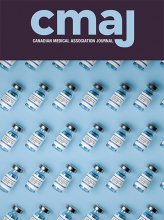Article Figures & Tables
Tables
Red flag Clinical features Etiologies to exclude S Systemic signs, symptoms or disease Fever, weight loss, HIV, immunosuppression, malignancy, pregnancy or postpartum Metastatic disease, CNS infection, CVST, RCVS, IIH N Neurologic symptoms or signs Neurologic deficits or atypical or prolonged neurologic symptoms, or both Neoplastic, inflammatory, infectious or vascular CNS disease O Onset (late) Headache onset after age 50 yr Neoplastic, inflammatory or infectious CNS disease; giant cell arteritis O Onset (sudden) Thunderclap headache with onset to maximum intensity in < 60 s Subarachnoid hemorrhage, CVST, RCVS, arterial dissection P Papilledema Optic disc swelling (with or without pulsatile tinnitus, diplopia, transient visual obscuration, weight gain) Raised intracranial pressure (mass lesion, hemorrhage, edema, CVST, IIH) P Postural aggravation Headache worsened or triggered by standing or lying down Intracranial hypotension (cerebrospinal fluid leak), intracranial hypertension (IIH, mass lesion) P Precipitated by valsalva Headache triggered by valsalva (coughing, exercise or intercourse) Chiari malformation, mass lesion (e.g., posterior fossa) P Pattern change or progressive Change in previously stable pattern (loss of headache-free periods) or progressively worsening headache with evolving clinical symptoms Any secondary cause Note: CNS = central nervous system, CVST = cerebral venous sinus thrombosis, IIH = idiopathic intracranial hypertension, RCVS = reversible cerebral vasoconstriction syndrome.
Drug category Drug(s) Canadian Headache Society Level of evidence* Strength of recommendation† Recommended for use in episodic migraine Triptans Almotriptan, eletriptan, frovatriptan, naratriptan, rizatriptan, sumatriptan, zolmitriptan High Strong Acetaminophen and NSAIDs Acetaminophen, acetylsalicyclic acid, diclofenac potassium, ibuprofen, naproxen sodium High Strong Combination analgesics Naproxen–sumatriptan High Strong Anti-emetics (adjunct) Metoclopramide Moderate Strong Domperidone Low Strong Ergots Dihydroergotamine (nasal, subcutaneous) Moderate Weak Not recommended for routine use in episodic migraine‡ Ergots Ergotamine Moderate Weak Opioids and tramadol Opioids or opioid-containing combination analgesics Low Weak Tramadol or tramadol-containing combination analgesics Moderate Weak Not recommended for use in episodic migraine§ Synthetic opioids Butorphanol nasal spray Low Strong against Barbiturates Butalbital-containing combination analgesics Low Strong against Note: GRADE = Grading of Recommendations Assessment, Development and Evaluation, NSAID = nonsteroidal anti-inflammatory drug.
↵* Levels of evidence using the GRADE system: high = the guideline authors are confident that the true effect lies close to the estimate given by the evidence available; moderate = the guideline authors are moderately confident in the effect estimate, but there is a possibility it is substantially different; low = the confidence in the effect estimate is limited and the true effect may be substantially different; very low = the guideline authors have little confidence in the effect estimate.
↵† Recommendation categories using the GRADE system: strong = benefits clearly outweigh risks and burdens for most patients; weak = the balance between benefits and risks is narrow and there is uncertainty about when it should be used.
↵‡ Not recommended for routine use but may be considered for occasional use when other medications have failed.
↵§ Should be avoided except in exceptional circumstances.
Adapted with permission from Worthington I, Pringsheim T, Gawel MJ, et al.; Canadian Headache Society guideline: acute drug therapy for migraine headache. Can J Neurol Sci 2013;40(Suppl 3):S1–80.
- Table 3:
New pharmacologic therapies for acute treatment of migraine, with or without aura
Drug Ubrogepant Rimegepant* Lasmiditan† Mechanism of action CGRP receptor antagonist CGRP receptor antagonist 5-HT1F receptor agonist Dosing Oral: 50 or 100 mg as needed (max 2 doses/24 h) Oral or sublingual: 75 mg as needed (max 1 dose/24 h) Oral; 50, 100 or 200 mg as needed (max 1 dose/24 h) Adverse effects Nausea, dizziness and dry mouth Nausea and abdominal pain and dyspepsia Dizziness, drowsiness, paresthesia, nausea, vomiting and muscle weakness












Podcast